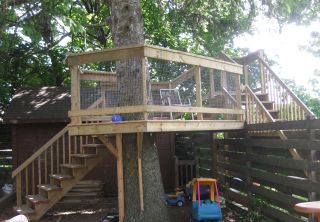Environment
Go Climb a Tree
Tree-houses are perfect for producing the positive effects of nature exposure.
Posted June 30, 2014

A few years ago, I recruited a neighborhood handyman to build a tree-house in my backyard. In part, this was to solve a problem: my children were good friends with the children who lived beside us and they liked to climb over the fence that separated the two yards. We could have just put a gate into the fence, but I decided that building some kind of climbable structure around the large fir tree that was in the yard that also included a staircase into the neighbor’s yard was a more creative solution to the problem, and I liked the idea that the tree-house would also serve to join the two play spaces together. The handyman took the task much more seriously than I had expected, and made drawings, built small wooden models, and even held a kind of ‘visioning’ exercise with the children and their parents to make sure that he hadn’t missed any important details. At the end of our lengthy discussions, he asked one more question:
“Where would you like me to put the beer rail?”
The question took me aback as I hadn’t really considered the possibility that a nice play structure in my yard might also facilitate beer consumption among the neighborhood children, but I quickly tuned into the fact that our designer had intuited what should have been obvious to me—that the children wouldn’t be the only ones taking advantage of this platform up among the branches of the beautiful old tree. And, indeed, over the years that I lived in that house I discovered that the platform made a pretty good perch, not only for the occasional cold beer, but also for sitting and dreaming, relaxing on a hot summer day, reading a book, enjoying a picnic or even getting some writing done. My children enjoyed clambering around in the tree-house, playing tag, setting up imaginary pirate ships and fortresses, but they also used it for some quiet thinking and even the occasional bout of math homework. The tree seemed to be a particularly good algebra tutor.
Tree-houses are enjoying something of a resurgence around the world. There are luxury tree-house hotels, more humble set-ups in forests and jungles, demonstration houses for sustainable living, and tree-houses set up by environmentalist activists as a form of protest against deforestation. But, in fact, the tree-house itself is a very old idea. In her Treehouse Book, author Candida Collins points out that the ancient Roman emperor Caligula had a treehouse on his estate at Velitrae, as did the Medici family in Renaissance Italy, and that tree-house dining was also occasionally enjoyed by British royalty, including Queen Elizabeth I. Tree-houses also figure famously in literature, as in Johann Wyss's book Swiss Family Robinson and in Harper Lee’s To Kill a Mockingbird in which the tree-house served as an important symbol of peace and remove from the fray of the everyday. And, indeed, there’s something very special about the combination of elevation above the normal plane of life’s existence and the sheltering branches of a tree that affords a unique opportunity for quiet contemplation and even meditation. We don’t even necessarily need to build a tree-house to enjoy some of these benefits. Some of my fondest childhood memories are attached to a large, old cherry tree that grew in the yard of my grandmother’s house. I would climb into the cockpit afforded by a large, gnarled, horizontal bough of that tree and spend hours there looking around at my surroundings and daydreaming about my life.
Now, there is an enormous body of evidence describing the beneficial effects of exposure to nature on the human psyche. We feel happier, less stressed, and we think more clearly when surrounded by views of nature. I can think of no better setting to enjoy these beneficial effects than when surrounded by the branches of a tree.
If your children ask you to build a tree-house this summer, don’t hesitate. Just make sure it’s big enough for the whole family to enjoy.


